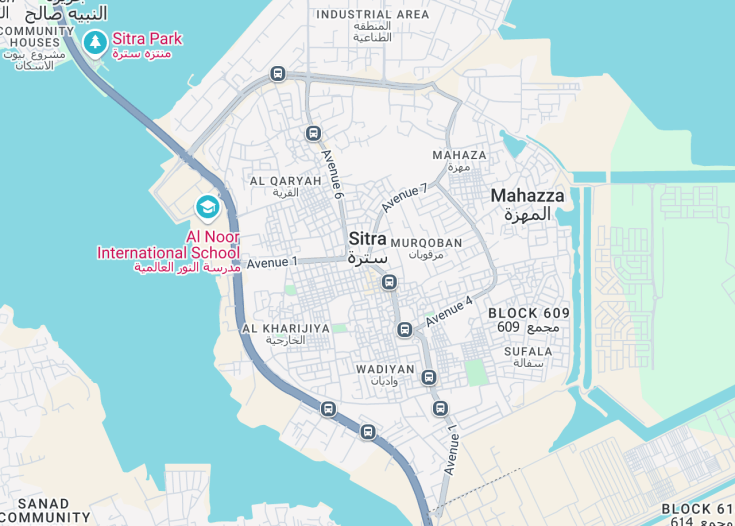Sitra, an island in Bahrain, captivates visitors with its vibrant mix of historical richness and modern allure. Known for its small industries and traditional boat making, Sitra also reveals a lesser-seen side of Bahrain through its quaint villages and bustling fish market. This destination offers an insightful glimpse into the authentic Bahraini lifestyle, making it a must-visit for those interested in the cultural and economic fabric of the region.
Before visiting Sitra, ensure to explore the local fish market early in the morning for an authentic experience of Bahraini daily life and fresh produce.
Consider a guided tour in Sitra to fully appreciate the intricate art of traditional boat building and the island’s unique cultural heritage.
Sitra: A Vibrant Hub in the Heart of Bahrain
| Country | Bahrain |
| Time in Sitra | GMT+3 |
| Language spoken | Arabic |
| Population | 75,000 (World Population Review) |
| Currency | Bahraini Dinar (BHD) |
| Airports |
|
Sitra, located in Bahrain, is a unique blend of ancient traditions and modern development. Known for its historical significance and vibrant marketplaces, Sitra occupies a strategic position in Bahrain and serves as a crucial point of cultural exchange. The town’s history dates back to ancient times when it was a bustling center of trade and commerce. Over the centuries, Sitra has preserved its rich heritage while adapting to the contemporary era, thus presenting a fascinating juxtaposition of old and new.
The marketplace of Sitra is particularly famous for its colorful stalls and the diversity of goods available, ranging from traditional Bahraini handicrafts to modern electronics. Local artisans often demonstrate their skills, making the market a lively place that attracts tourists and locals alike. Additionally, Sitra’s coastal location has made it a popular spot for fishing and pearling, activities that have shaped the local culture and economy over millennia.
Where is Sitra?
Sitra is an industrial suburb located south of Manama, the capital city of Bahrain, on its own island east of the main Bahrain Island.
Distances:
| Route | Distance by car | Time by car |
|---|---|---|
| Manama to Sitra | 5 miles (8 km) | 15 minutes |
| Muharraq to Sitra | 12 miles (19 km) | 25 minutes |
What is Sitra famous for?
Sitra is renowned for its rich cultural heritage and bustling marketplaces. The traditional markets of Sitra, or souqs, offer a vivid glimpse into Bahrain’s vibrant culture and are a popular draw for both tourists and residents.
History
Ancient Roots and Dilmun Civilization (2800 BC – 663 AD)
Long before the modern state of Bahrain emerged, the island of Sitra was a part of the ancient Dilmun civilization, one of the oldest trading societies in the Middle East. Sitra’s strategic position along the Persian Gulf made it a central maritime hub. It is believed that Sitra was involved in the early development of trade routes between Mesopotamia and the Indus Valley, dealing primarily in pearls and spices.
Islamic Era and Portuguese Control (630 AD – 1602 AD)
With the spread of Islam, Sitra became a significant port in the Islamic world. In the 16th century, the Portuguese recognized the strategic importance of Bahrain, including Sitra, to control the Persian Gulf. They built fortifications to protect their sea routes from the British and the Ottomans. However, local inhabitants frequently rebelled against Portuguese control, leading to a turbulent period of Sitra’s history.
Ottoman Influence and British Protection (1602 – 1971)
After the Portuguese, Sitra came under the intermittent rule of the Persians and the Omanis until the British Empire took a protective role over Bahrain in the 19th century. During this time, Sitra was primarily a quiet fishing village with pearling as its main industry, which suffered significantly with the development of cultured pearls in the 20th century.
Modern Era and Economic Expansion (1971 – Present)
Since Bahrain’s independence in 1971, Sitra has transformed dramatically. The discovery of oil nearby has led to economic prosperity and rapid modernization. Industrial areas have been developed, and infrastructure projects have improved the standard of living for its residents. However, it has also faced challenges such as political unrest and economic disparity among its population.
Visit Sitra
Attractions and Activities in Sitra
Sitra, a charming island in Bahrain, offers visitors a unique blend of historical sites and natural beauty. Not to be missed is the Sitra Fishermen Port, where one can observe traditional fishing techniques and perhaps even join a local fisherman for a day at sea. For those interested in history, the ancient ruins scattered around Sitra provide a glimpse into its rich past. Furthermore, the island is known for its beautiful beaches, ideal for a relaxing day under the sun or engaging in water sports.
Cultural Festivities in Sitra
Each year, Sitra hosts a variety of cultural events that celebrate its heritage and community spirit. One of the highlights is the Sitra Cultural Festival, held in spring, where traditional dances, music performances, and local cuisine are showcased. Additionally, the Annual Fishing Festival in early autumn highlights the island’s long-standing fishing traditions with competitions, workshops, and fresh seafood stalls.
Best time to visit Sitra
The ideal time to visit Sitra is between November and March when the weather is cooler and more comfortable for exploring outdoors. This period avoids the extreme summer temperatures that can be quite oppressive.
Is Sitra worth visiting?
Sitra offers a unique perspective on Bahrain’s heritage and its modern transformations. The island’s historical ruins, bustling fishing ports, and tranquil beaches provide a diverse range of activities for all types of travelers. However, visitors seeking a fast-paced urban environment may find it less appealing. The infrastructure, while improved, can still pose challenges to accessibility. Balancing its serene setting with its rich cultural tapestry, Sitra can be a rewarding destination for those interested in exploring beyond the typical tourist paths.









